As each year nears its end, Practical Sailor editors find themselves poring over the dozens of products reviewed in the previous months to choose the must-haves for the Practical Sailor Gear of the Year roster. This year, we mounted that task a little earlier, hoping that readers will benefit from having our top picks for 2009 in time for the fall boat shows (and boat show deals).
As with past picks, the 2009 Gear of the Year awardees are the cream of the crop, and this year, we chose from products evaluated in the November 2008 to July 2009 issues.
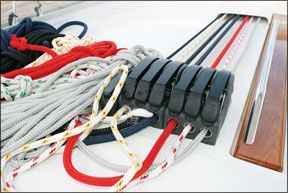
Photo by Ralph Naranjo
Rope Clutches
Spinlock XCS: Topping our evaluation of quality rope clutches in the March 2009 issue (and the test update in the June 2009 issue) was the aluminum-bodied Spinlock XCS clutch. This $180 unit edged out products from Antal, Lewmar, and Garhauer.
The XCS is identical to the high-strength-plastic Spinlock XTS, except that it has a metal body, a plus for those applications where it could get whacked by a spinnaker pole or other similar abuse
The XCS, which uses the 0814 cam system and has a five-year warranty, was easy to thread, allowed a butter-smooth pull (even when in latch-down mode), and featured a comfortable, ergonomic handle design. During testing, only 22 pounds of pull was required to release the clutch under load.
The Spinlock XCSs jaws clamped down vigorously on the line, held with minimal initial slippage, and had enough surface area to spread the load, helping to minimize cover abrasion on the line. The inner workings were easy to access, and a close look at the design of the gripping components revealed lots of surface area for good line contact.
The well-designed XCS clutch excelled in all tests, earning it a spot on the 2009 Gear of the Year roster.
Gripper Ratchet Blocks
Ronstan 55 (RF56101):The most common uses for ratchet blocks are on smaller racing boats, where youre working a sheet by hand and wouldnt think of belaying it to a cleat. There are applications for larger, cruising boats, too, like the control line on a headsail furler, traveler control lines, and genoa lead adjusters. On any line that youre trimming by hand rather than with a winch, the ratchet block reduces the amount of strength required.
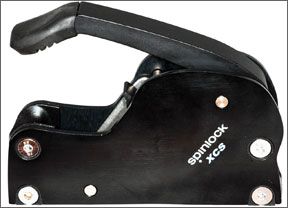
In the May 2009 issue, testers sought out a mid-size (55- to 60-millimeter) ratchet block with the best grip. We evaluated blocks from Swedish sparmaker Seldn, British hardware maker Holt Allen, French stainless-steel expert Wichard, Australias Ronstan, and Wisconsin-based Harken Yacht Equipment.
In the holding power competition, the Ronstan 55 impressed by resisting more than twice the load of the others-an average of 82 pounds. It placed second in the friction test.
The $55 Ronstan was the only one tested that offered automatic and manual modes in one block. The sheave is anodized aluminum, and the stage-two bearing is reinforced glass fiber. Cheeks are glass fiber-reinforced nylon, and the fiber strop or head link is UV stabilized, multistrand Dyneema.
While this test focused primarily on finding the best gripper, there are applications where less grip is desirable-for example, mainsheet control on a small boat-and the other test products may prove more useful for those. The Harkens slippery sheave is good for light-load tweaking, and the Seldn is a true friction fighter.
Nesting Cookware
Magma Professional 10-Piece:A good set of nesting cookware means galley gourmets can have all the tools they need, without sacrificing storage space. The detachable handles also mean more pots can fit on the small galley-stove top. The sets only downside is that they often are more expensive than standard cookware sets.
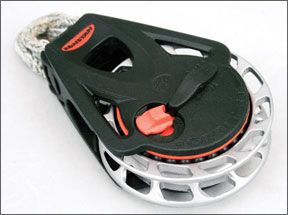
In April 2009, we reviewed four sets priced at less than $250. All featured removable handles and were suitable for use on gas, electric, and alcohol stoves. Magma Products 10-piece set was testers top pick over offerings from Cuisinart, Galleyware Co., and camping-gear maker GSI Outdoors.
All of the cookware sets were evaluated and rated on what the set includes; construction materials; handle construction, function, and ergonomics; storage accessories, storage space required, and whether the sets rattled underway; performance; ease of cleaning; price; and warranty. We also rated the handles on ease of attaching and how securely they attached to the pans.
The Magma set, made from 18/10 stainless steel, was the highest-priced group in this test, but it was the only set to earn across-the-board Excellents in our tests and long-term testing since has supported the ratings, earning the set Gear of the Year status.
The Magma cookware is available with or without Dupont Teflon coating and comes with three saucepans, a 5-quart stock pot, a large saut pan, and a dedicated 10-inch lid that fits the saut pan and stock pot. Consumers also can buy pieces of the Magma set individually from the companys website, a bonus for those looking for replacement or extra pieces. Building your own set from the site is possible, but more expensive than choosing a pre-fab kit.

Paste Waxes
Collinite No. 885 Fleetwax: In the last year, Practical Sailor testers applied dozens of waxes and polishes to fiberglass test panels and our test boats. We split the test field into categories based on type of wax: paste waxes, liquid waxes, and cleaner-waxes.
The February 2009 issue launched the test of paste waxes, which have typically provided the longest-lasting protection in past Practical Sailor comparisons, and the July 2009 issue reported on the products performance after six months of exposure to the South Florida weather.
We reviewed a sampling of 10 high-solids pastes that were available in the old-style metal cans or newer plastic tubs and were promoted as a final step in surface finishing/sealing. The test field included products from 3M, Collinite, Kit, Meguiars, Mothers, Nu-Finish, Star brite, and Turtle Wax.

These were rated for ease of application, gloss, and water beading. After six months, the standout was Collinite No. 885 Fleetwax, which was also a Practical Sailor top-rated product in 2004. Its continued ability to bead water and repel dirt, and consistent excellent performance in our tests place it on the 2009 Gear of the Year roster.
Because the hard, non-abrasive paste wax is a heavier wax, it takes some serious rubbing to get on and buffing to get off, but it does machine buff to a brilliant shine. Although its somewhat pricey-$29 for 12 ounces, so use sparingly-it gets our pick for machine application.
First-Aid for Ocean Voyaging
Adventure Medical Marine 3000: Practical Sailor wrapped up its series on pre-packaged, seagoing first-aid kits with the December 2008 evaluation of medical kits for ocean voyaging. The test sought out the most comprehensive kit priced under $1,000 for vessels engaged in offshore passagemaking or remote cruising, where medical assistance could be several days or more away. The extensive evaluation of onboard medical kits looked at the quality and comprehensiveness of the contents, how well the kit was organized, reference material included, and cost.
The winning ocean voyaging kit and 2009 Gear of the Year safety pick was supplied by Adventure Medical Kits, a California-based outdoor safety gear maker that has repeatedly rated well in our tests.
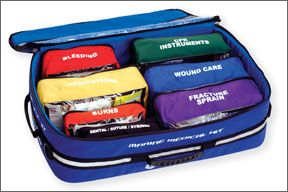
AMKs Marine 3000 is the companys top-of-the-line offering. It contains seven injury- or sickness-specific modules that offer a comprehensive assortment of medical supplies. The modules including dental, wound care, medicine, bleeding, CPR/instrument, blister/burn, and fracture/sprain. Each water-resistant section is clearly identified and its contents easily viewed via large vinyl windows. This kit will enable sailors to deal with some fairly intricate emergency medical situations. A Foley catheter, an enema bag, and nasal airway tubes are supplied, as are a stethoscope, temporary cavity fillings, and a skin stapler.
Not only is the Marine 3000 well-stocked, it is contained in a well-designed and manufactured case. This padded nylon valise has a water-resistant zipper and is trimmed with a reflective band to help users locate the case at night or in low-light situations.
The Marine 3000 also comes with one of the best reference manuals in the business: Dr. Eric Weiss and Dr. Michael Jacobs “A Comprehensive Guide to Marine Medicine.” The cost of the Marine 3000 is $795, less than all of the other kits tested in its group.
LED Bulbs for Bulkhead Lights
Imtra ILGU5.3 MR16 cool 3-watt: An ever-evolving market, LED lights have come
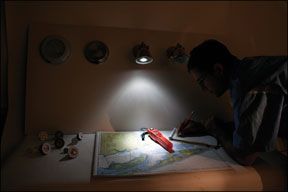
a long way in recent years and are now used in a variety of applications. They are available for everything from cabintop puck lights to navigation lights.
Practical Sailor
The cool-colored ILGU5.3 bulb from Imtra, a major original equipment manufacturer for interior lighting, topped the 16-product field of 10- to 20-watt xenon bulbs from makers including Alpenglow, Sailors Solutions, Cruising Solutions, Doctor LED, and Daniel R. Smith and Associates (DRSA, distributor for Mast Products). Testers evaluated the lights usable beam angle and intensity, power consumption, color temperature, and radio frequency interference.
At 111 lumens and 2.9 watts, the Imtra ILGU5.3 MR-16 “cool” bulb was the brightest of the group, earning it the Best Choice for reading and a Gear of the Year pick. The “warm” version of the same bulb was a closer color match to a 20-watt xenon reading lamp.
The Imtra ILGU5.3 MR-16 comes in a heavy-duty MR-16 size housing, and sports a substantial heat sink and magnifying glass lens. The housing is completely sealed and designed to withstand high heat and humidity and constant vibration.
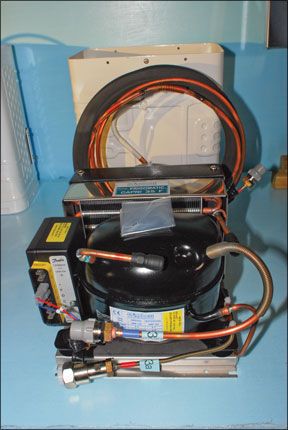
Note that the January comparison encompassed only a small cross-section of the offerings from these and other makers, and there may be better bulbs for specific needs. But if brightness is a priority and you can spare the milliamps-it measured .34 amps, about twice other test bulbs-the $28 ILGU5.3 LED is an excellent choice.
Ice Box Conversion Kits
Frigoboat Capri 35F: From cube ice in a cooler to a power-eating portable refrigerator, there are a number of options available for keeping food and drinks cool onboard. On many older cruising boats, that option is an ice box in the galley that is cooled with block ice. Upgrading to an electric refrigerator can be a costly and involved task, and isn’t worth considering for most modest-sized sailboats. However, do-it-yourself conversion kits offer a less expensive, easy-to-install option that turns a well-insulated ice box into a full-fledged 12-volt refrigerator and/or small freezer. Practical Sailor reviewed several of these in the June 2009 issue. At the head of the class was the air-cooled Frigoboat Capri 35F, a compact, efficient, and extremely well-made system.
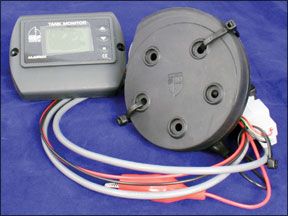
The other units tested were the Waeco-Adler Barbour Cold Machine (CU-100) from Dometic Corp. and the Sea Frost BD. All were easy to install and well suited for a do-it-yourself installation. They use Danfoss hermetically sealed compressors, which house a miniaturized drive motor and compressor inside a grapefruit-size airtight tank.
One of the Frigoboat features testers liked most was the manual mode, an option that lets the user select the most efficient, low-power setting (2,000 RPM). This setting, which runs the compressor at a slower speed for a longer period, is useful for boats that depend on alternate energy sources such as solar and wind power.
The Capri 35F is efficient, packs quite a bit of capacity in a small package, and ranks high with regard to attention to details and construction quality. The attention to soldering detail and care taken with the overall refrigerant plumbing was exemplary as was the overall design of the system. It earns a spot among this years Gear of the Year.
Internal Tank Sensor Kits

Photo by Ralph Naranjo
0)]
BEP Marine TS1 / 600-TLM: In the May 2008 issue, Practical Sailor reviewed seven internally mounted holding tank sensors and their mated remote monitor panels, rating them for ease of installation, quality of workmanship and materials, features, performance, and accuracy. That month also marked the launch of the kits long-term performance test. For nine months, the sensors marinated in fake effluent in our test holding tank of to see how well they held up to being submerged in waste over time.
The July 2009 report offered our findings: Float-type sensors fared the worst, and the ultrasonic TS1 by BEP Marine (Marineco Electrical Group) was testers favorite. The test products with some form of float sensor were the SeaLand TankWatch 1, Dometic DTM4, Groco TLM Series, and Wema SHS-8. Two others used air pressure for reading: Fireboy-Xintex PTS and Hart Systems Tank Tender.
BEPs TS1, tested with the 600-TLM monitor display, had the most unique and sophisticated system of any tank monitor tested. It uses an acoustic sonar technology to read the amount of liquid in a tank. The ultrasonic technology is extremely accurate, and the digital screen shows liquid levels three ways: in gallons, as a percentage full, and with a bar graph.
After nine months of cooking in the goop in Florida, the BEP sensor fired up and worked perfectly. By design, there is no way for the “gunk” to foul it up.
At $380, it is not cheap, but the sonar technology worked flawlessly, was easy to install, and has a host of interesting features and functions. The 600 TLM will monitor up to three tanks with selectable labels in English, adjustable high-low level alarms, and is backlit for easy night-time viewing.

Photo by Ralph Naranjo
1)]
Cold Weather Gloves
Gill Helmsman: Among a sailors most-used tools are his hands. Keeping them warm and dry in the foulest of weather is a must, but it can be challenging to find a pair of gloves that serves all of a sailors cold-weather needs. The range of conditions-from chilly to freezing, from dry to soaking-and the conflict between having warm hands and being able to freely move those hands mean that most winter sailors carry a variety of gloves and select the ones that best match the conditions.
We tested 14 different pairs of gloves from 10 different makers in the November 2008 issue, and although our quest for the perfect glove fell short, testers agreed that the Gill Helmsman was best in class for cold-weather sailing gloves. The glove bested other sailing gloves from Gill, Gul, Henri Lloyd, and Musto; waterproof snowboarding/skiing gloves by L.L.Bean, The North Face, and Zero Gloves by Fairfield Line; specialty gloves from SealSkinz, Danalco, and Stearns; and lined “rubber” (PVC, nitrile, or latex) gloves designed for industrial applications. Testers wore the gloves in a range of weather conditions and during typical cruising activities. The gloves also were put through a series of bench tests.
The Gill Helmsman, an upgrade to the winning gloves from our previous test, has plenty of insulation and a water-resistant, breathable (but not removable) liner. The wide cuff allows the glove to go smoothly over jacket sleeves, and the drawstring on the cuff and the wrist strap can be snugged to prevent water dripping into the gloves. The wicking inner lining makes it easy to get the gloves on and off, even with wet hands.
These gloves passed the immersion test, and proved to be warm, dry, and comfortable, with excellent grip and sufficient dexterity for all but fine-finger tasks, making them our apparel pick for Gear of the Year.

Photo by Ralph Naranjo
2)]
Wi-Fi
5MileWiFi: In this digital age, staying connected is easier than ever, even on a boat. An onboard laptop with built-in Wi-Fi is nearly as common on cruising and live-aboard boats as furling gear. The challenge, however, comes in securing a suitable signal. A marina is a difficult location for a low-power, high-frequency radio signal to exist. A forest of metal masts and other obstructions steal a bit of the signals strength before it ever reaches the laptop.
Among the solutions for getting a better wireless signal onboard is mounting an external antenna as high as possible and connecting it to a Wi-Fi device. Enter the 5MileWiFi system-a self-contained, “plug-and-play” setup that does it all and is designed specifically for marine use-which Practical Sailor reviewed in the January 2009 issue. It comprises a 38-inch, 9-decibel external antenna and mount, 25 feet of low-loss antenna cable, and a small aluminum case, or chassis, that contains both a 1-watt bidirectional amplifier and the Wi-Fi adapter that are powered by the computers USB ports.
We found the 5MileWiFi system installation to be fairly straightforward, and tests on the water and on the dock showed the device performed as advertised.
The 5MileWiFi adapter requires a fair amount of power and may overload the computers USB power capabilities. If you are using an older laptop or if in doubt, consider ordering the optional 12-volt DC or 115-volt AC power adapters.
At $399, 5MileWiFi is pricey, but it boosts connectivity as advertised and is our computer geek Gear of the Year pick.
reviewed a sampling of marine-ready LEDs in the January 2009 issue, with a test of LED replacement bulbs for bulkhead-mounted reading lights, a common fixture on sailboats.








































Эй, приветик! Кто-то из подписчиков моей страницы в MySpace подписан на
автора этого сайта и может перейти
туда, чтобы посмотреть отличные материалы?
Я оставил закладку и обязательно
поделюсь с моими подписчиками!
Прекрасный блог, превосходный стиль и
дизайн.